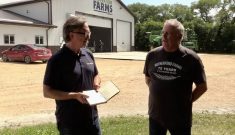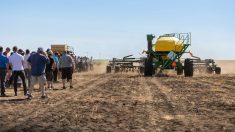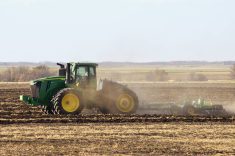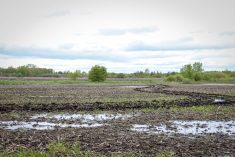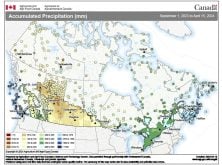Organic farmers are gearing up for a more complicated start to the growing season after missing much of their field work last fall.
Last year’s “harvest from hell” is still sending shocks through Manitoba operations, with wet weather leaving many farmers with unharvested acres and incomplete fertilizer applications.
For the organic sector, that same delay in field work comes with implications for weed control. Many organic farmers also failed to complete the fall tillage passes critical for controlling perennial weeds.
Why it matters: For organic producers, who rely on field work for weed control, those missed passes last fall have lots of implications for the coming season.
For those farmers, according to organic grower John Finnie of Crocusview Farm near Kenton, that may mean delaying seeding to make up for some of those passes this spring.
“It’s going to be more difficult to get seeding operations underway in a timely fashion, depending on what your plans are for any specific field,” he said “The good news is that we have an adequate supply of moisture, whereas last spring it was quite dry and then followed up by a really dry spring until midsummer.”

As of March 27, Manitoba’s ag weather network was reporting soil moisture anywhere from 11 to 30 per cent at five centimetres down in central Manitoba, while most of eastern Manitoba and the Interlake hovered in the high teens.
Nick Boundy of Boissevain also says he was unable to complete his usual weed control passes, something that will likely impact efforts to control Canada thistle.
“We’ve found that perennial weed control in the spring is pretty much a bust. We’ve tried it in the past,” he said.
All of Boundy’s cereals were harvested by the time the weather turned wet last fall, he said, and he was able to complete several hundred acres of fall tillage. Even then, however, Boundy says he does not expect those passes to yield much control, thanks to their timing.
Read Also

Local farm businesses, groups look forward to Manitoba Ag Days 2026
Most of agriculture is seemingly at Manitoba Ag Days each January: Manitoba agribusinesses and farm groups look forward to connecting with farmers at the 2026 show.
“It was probably too early in the season and there wasn’t a long enough period between the tillage and the rain,” he said.
Many of those thistles may very well have re-rooted.
Boundy’s strategy this year will be firmly planted in competitive advantage. Spring efforts may knock back those perennial weeds long enough to establish his crop, he said, while he has changed his seeding plans to plant more competitive crops.
The CombCut may also be getting more of a workout this year. Boundy noted that the mechanical weed control equipment might be critical for keeping his expected flush of weeds from setting seed, and thus cutting off any long-term impact from last year’s bad fall.
“And then, obviously, this fall we’ll be trying to play catch-up, so we’ll be hopefully taking care of those issues then,” he said.
Watching spring
Farmers are also watching the spring forecast with a wary eye.
Unworked fields will likely retain more moisture and delay a likely already delayed seeding if the spring turns wet, Finnie said.
“If we have a cold, wet spring, it’s going to make things worse,” he said. “If we have a nice, dry, early spring, then it shouldn’t be such a big deal.”
For David Rourke, who farms near Minto, the concerns feel very similar to 2017, another year where farmers were coming off a wet fall and were concerned that wet weather might derail spring plans.
“If we don’t get an early spring, we’ll just keep trying until we can’t try anymore,” he said, noting that his farm opted for its maximum excess moisture insurance level and is looking at other insurance as a buffer against the potential risk.
His region has seen less snowfall than usual, he noted, something that has given some hope for the coming months.
According to provincial ag weather data, the Minto area logged 25 per cent or less of normal precipitation from Nov. 1, 2019 to March 22, 2020.
“Our philosophy is just to sow wheat as quickly as we can and if the spring is delayed, then we’ll have to do a tillage pass or two before (seeding),” Rourke said in terms of weed control. “If we get an early spring and get out into the fields, we’ll just go and sow it and then harrow a lot to control weeds.”
The organic sector has, however, dodged many of the fertility questions that conventional farmers face due to their lack of fall field work, Rourke noted.
Their own fertility is based around green manures rather than inputs applied during the fall, and so was not impacted by the limited ability to get into the field last fall.





